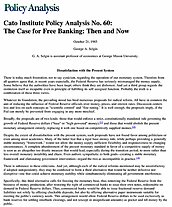Dissatisfaction with the Present System
There is today much frustration, not to say cynicism, regarding the operation of our monetary system. Theorists from all quarters agree that, in recent years especially, the Federal Reserve has seriously mismanaged the money supply. Some believe that the authorities have been inept; others think they are dishonest. And yet a third group regards the institution itself as incapable even in principle of fulfilling its self-assigned function. Probably the truth is a combination of these three views.
Whatever its foundation, the prevailing mood has bred numerous proposals for radical reform. All have in common the aim of reducing the influence of Federal Reserve officials over money, prices, and interest rates. Discussion centers less and less on such concepts as “scientific control” and “fine tuning.” It is well enough, the proposals imply, if the Fed can merely be prevented from engaging in any more mischief.
Broadly, the proposals are of two kinds: those that would enforce a strict, constitutionally mandated rule governing the growth of Federal Reserve dollars (“base” or “high-powered” money),[1] and those that would abolish the present monetary arrangement entirely, replacing it with one based on competitively supplied monies.[2]
Despite the extent of dissatisfaction with the present system, such proposals have not found favor among politicians or even among most academics. Many of the latter fear that a rigid base-money rule, while perhaps providing a generally stable monetary “framework,” would not allow the money supply sufficient flexibility and responsiveness to changing circumstances. A complete abandonment of the present monetary standard in favor of a competitive supply of money is seen as an altogether too drastic measure that would lead, especially during the transition period, to more rather than less overall monetary instability and chaos. Even authors sympathetic to both goals–creating a stable monetary framework and eliminating government intervention–regard the two as incompatible in practice.[3]
There is substance to these criticisms. And yet, although each of the radical reforms mentioned may be unsatisfactory if adopted independently, they may be combined to form a third alternative that would be neither defective nor disruptive–one that could achieve monetary stability while simultaneously eliminating all government interference.
Specifically, this third alternative calls for freezing the monetary base, thus removing the Federal Reserve from the business of money production, after restoring the right of commercial banks to issue their own notes, redeemable on demand in Federal Reserve dollars. Thus, commercial banks would be able to issue fractional-reserve demand liabilities not solely by offering checkable deposits, but also by offering alternative paper instruments suitable for meeting the public’s currency needs. This arrangement would allow Federal Reserve dollars to be used exclusively as bank reserves for settling interbank clearings, and not (except in insignificant amounts) as pocket and till money by the public.
Although the proposal outlined here may seem revolutionary, it is not, resembling in some respects the pre-Federal Reserve arrangement that functioned from 1863 to 1913. However, at least part of the time, the pre-Federal Reserve system (the National Banking System) operated on a gold standard,[4] whereas the present proposal assumes a continuation of the current paper-dollar standard. More significantly, the National Banking System suffered from serious regulatory defects that the present proposal avoids. To place this proposal in perspective, a review of the history of the National Banking System is in order, revealing how the defects of that system might easily have been cured through deregulation instead of the establishment of a central bank.

This work is licensed under a Creative Commons Attribution-NonCommercial-ShareAlike 4.0 International License.

